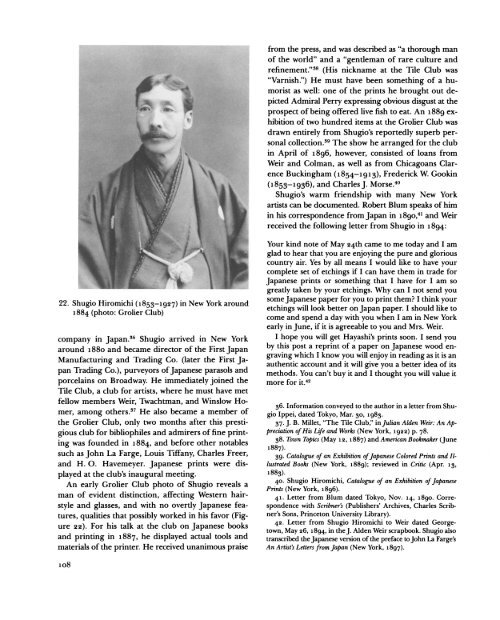Early Collectors of Japanese Prints and The Metropolitan Museulm ...
Early Collectors of Japanese Prints and The Metropolitan Museulm ...
Early Collectors of Japanese Prints and The Metropolitan Museulm ...
Create successful ePaper yourself
Turn your PDF publications into a flip-book with our unique Google optimized e-Paper software.
22. Shugio Hiromichi (1853-1927) in New York around<br />
1884 (photo: Grolier Club)<br />
company in Japan.36 Shugio arrived in New York<br />
around 1880 <strong>and</strong> became director <strong>of</strong> the First Japan<br />
Manufacturing <strong>and</strong> Trading Co. (later the First Japan<br />
Trading Co.), purveyors <strong>of</strong> <strong>Japanese</strong> parasols <strong>and</strong><br />
porcelains on Broadway. He immediately joined the<br />
Tile Club, a club for artists, where he must have met<br />
fellow members Weir, Twachtman, <strong>and</strong> Winslow Homer,<br />
among others.37 He also became a member <strong>of</strong><br />
the Grolier Club, only two months after this presti-<br />
gious club for bibliophiles <strong>and</strong> admirers <strong>of</strong> fine print-<br />
ing was founded in 1884, <strong>and</strong> before other notables<br />
such as John La Farge, Louis Tiffany, Charles Freer,<br />
<strong>and</strong> H. 0. Havemeyer. <strong>Japanese</strong> prints were displayed<br />
at the club's inaugural meeting.<br />
An early Grolier Club photo <strong>of</strong> Shugio reveals a<br />
man <strong>of</strong> evident distinction, affecting Western hairstyle<br />
<strong>and</strong> glasses, <strong>and</strong> with no overtly <strong>Japanese</strong> fea-<br />
tures, qualities that possibly worked in his favor (Figure<br />
22). For his talk at the club on <strong>Japanese</strong> books<br />
<strong>and</strong> printing in 1887, he displayed actual tools <strong>and</strong><br />
materials <strong>of</strong> the printer. He received unanimous praise<br />
108<br />
from the press, <strong>and</strong> was described as "a thorough man<br />
<strong>of</strong> the world" <strong>and</strong> a "gentleman <strong>of</strong> rare culture <strong>and</strong><br />
refinement."38 (His nickname at the Tile Club was<br />
"Varnish.") He must have been something <strong>of</strong> a humorist<br />
as well: one <strong>of</strong> the prints he brought out depicted<br />
Admiral Perry expressing obvious disgust at the<br />
prospect <strong>of</strong> being <strong>of</strong>fered live fish to eat. An 1889 exhibition<br />
<strong>of</strong> two hundred items at the Grolier Club was<br />
drawn entirely from Shugio's reportedly superb personal<br />
collection.39 <strong>The</strong> show he arranged for the club<br />
in April <strong>of</strong> 1896, however, consisted <strong>of</strong> loans from<br />
Weir <strong>and</strong> Colman, as well as from Chicagoans Clarence<br />
Buckingham (1854-1913), Frederick W. Gookin<br />
(1853-1936), <strong>and</strong> Charles J. Morse.40<br />
Shugio's warm friendship with many New York<br />
artists can be documented. Robert Blum speaks <strong>of</strong> him<br />
in his correspondence from Japan in 1890,41 <strong>and</strong> Weir<br />
received the following letter from Shugio in 1894:<br />
Your kind note <strong>of</strong> May 24th came to me today <strong>and</strong> I am<br />
glad to hear that you are enjoying the pure <strong>and</strong> glorious<br />
country air. Yes by all means I would like to have your<br />
complete set <strong>of</strong> etchings if I can have them in trade for<br />
<strong>Japanese</strong> prints or something that I have for I am so<br />
greatly taken by your etchings. Why can I not send you<br />
some <strong>Japanese</strong> paper for you to print them? I think your<br />
etchings will look better on Japan paper. I should like to<br />
come <strong>and</strong> spend a day with you when I am in New York<br />
early in June, if it is agreeable to you <strong>and</strong> Mrs. Weir.<br />
I hope you will get Hayashi's prints soon. I send you<br />
by this post a reprint <strong>of</strong> a paper on <strong>Japanese</strong> wood engraving<br />
which I know you will enjoy in reading as it is an<br />
authentic account <strong>and</strong> it will give you a better idea <strong>of</strong> its<br />
methods. You can't buy it <strong>and</strong> I thought you will value it<br />
more for it.42<br />
36. Information conveyed to the author in a letter from Shugio<br />
Ippei, dated Tokyo, Mar. 30, 1983.<br />
37. J. B. Millet, "<strong>The</strong> Tile Club," inJulian Alden Weir: An Appreciation<br />
<strong>of</strong> His Life <strong>and</strong> Works (New York, 1922) p. 78.<br />
38. Town Topics (May 12, 1887) <strong>and</strong> American Bookmaker (June<br />
1887).<br />
39. Catalogue <strong>of</strong> an Exhibition <strong>of</strong> <strong>Japanese</strong> Colored <strong>Prints</strong> <strong>and</strong> Illustrated<br />
Books (New York, 1889); reviewed in Critic (Apr. 13,<br />
1883).<br />
40. Shugio Hiromichi, Catalogue <strong>of</strong> an Exhibition <strong>of</strong> <strong>Japanese</strong><br />
<strong>Prints</strong> (New York, 1896).<br />
41. Letter from Blum dated Tokyo, Nov. 14, 1890. Correspondence<br />
with Scribner's (Publishers' Archives, Charles Scribner's<br />
Sons, Princeton University Library).<br />
42. Letter from Shugio Hiromichi to Weir dated Georgetown,<br />
May 26, 1894, in theJ. Alden Weir scrapbook. Shugio also<br />
transcribed the <strong>Japanese</strong> version <strong>of</strong> the preface to John La Farge's<br />
An Artist's Letters from Japan (New York, 1897).

















